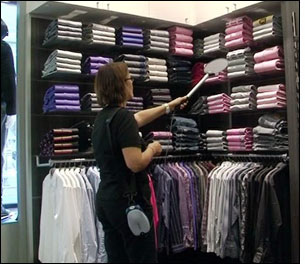French luxury sportswear designer and retailer Serge Blanco has expanded the item-level RFID tracking system it launched in 2009, by testing the tags at the retail level for tracking inventory at one of its stores. If the pilot goes well, the company intends to equip its other retail locations with handheld RFID interrogators, to track products as they are received and moved to sales-floor shelves, as well as fixed reader portals at dressing rooms and exits. The store testing the system, located in Toulon, France, is using RFID interrogators and software from Tagsys—the same French company that provided the clothing retailer with its initial supply chain visibility solution last year (see Serge Blanco Finds ROI in RIFD).
Since workers at Serge Blanco’s clothing factories already tag every garment the company sells, the use of RFID interrogators at the store could further the technology’s benefits, says Mathieu Pradier, the firm’s VP of operations. Initially, he says, when it began tagging each item of clothing at the point of manufacture, “the main goal was logistics.” The company wanted to improve its distribution center’s capacity to manage its 30 percent yearly growth. After it began using RFID to accomplish this goal, he explains, Serge Blanco began seeking other applications for the technology as well.
According to Pradier, the Toulon store is serving “as a kind of laboratory for the brand.” If the system successfully increases inventory visibility, decreases out-of-stocks, and reduces manual labor and improve sales, he says, the firm intends to expand the installation to all 40 of the stores it owns and operates.
Serge Blanco primarily makes men’s clothing, which it sells at its own stores, as well as at 320 third-party retail sites throughout France, Russia, Italy, Ireland and Dubai. Due to the company’s fast growth, in 2008 it assessed whether it needed to expand its distribution center (creating a new building and adding new employees), or try to optimize the flow of goods through its existing facility. The firm chose the latter path, using RFID tags (attached to garments at the point of manufacture) to gain the visibility that would make this possible. The company is utilizing RFID to track where goods are located—from the items’ receipt at the DC to the point of shipment to the stores—and ensure they are shipped at the right time, and to the proper destination.
Since March 2010, the Toulon site’s staff has been using five Tagsys HHU-400 handheld interrogators to read the tags as garments are received at its store, as well as for inventory checks on the sales floor. Employees at the Toulon store conduct inventory counts throughout the day, using handheld interrogators to read the RFID tags of all items on the sales floor. When an item is purchased, a sales clerk utilizes a bar-code scanner attached to a point-of-sale (POS) terminal to identify the outfit being sold, and its tag is then removed.
“They are currently in the process of defining the best practices,” says Alain Fanet, Tagsys’ CEO. The staff uses the handhelds to take inventory of all items in the store—both in the back room and on the sales floor—once every hour. The company intends to measure the impact of this process on its inventory count, the manpower expended or saved, and any additional benefits gained by the technology’s use.
A Tagsys fixed RFID reader has also been installed in the fitting rooms, in order to capture the tag ID numbers of all garments brought into that area to be tried on. That information can then be compared with the POS data to determine which items are tried on and not purchased.
Another fixed interrogator was installed at the store’s exit. If the device reads any tags in its vicinity, an alert is sounded to warn that an item is being removed from the store with its RFID tag still attached—possibly an indication that the garment is being stolen. Based on the ID numbers of the tags read by the exit interrogator, the store also knows the exact clothing being removed.
When any of the fixed or handheld interrogators deployed at the store read the tags’ encoded IDs, that information is transmitted to the company’s back-end system, where Tagsys’ middleware—known as e-Connectware—interprets the data and forwards it to Serge Blanco’s inventory-management application on its own enterprise resource planning (ERP) system. The store can then use that information to determine which items are in stock, as well as which are missing from the sales floor, and then reconcile that data with POS data to determine whether the item was sold, as well as indicate when garments need to be re-ordered.
The use of RFID at the distribution center has proven to decrease labor, Serge Blanco reports. Prior to employing RFID, the DC required 10 workers to receive 25,000 items arriving on a busy day. With the Tagsys system installed, it now needs only two employees to perform the same job—and they can receive 35,000 items. The system could then alert the DC staff if any stock requires replenishment.
The company has a yearly budget of €300,000 ($396,000) to continue upgrading the system, Fanet says, which includes expanding to the other stores. To date, the use of RFID has saved labor in the distribution centers by automating the receipt and shipping data. “We have reduced entry and exit times for goods almost tenfold,” Pradier notes, “which means that we are now ready for business growth of 40 to 50 percent.”


